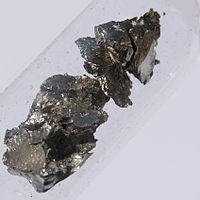
Photo from wikipedia
Monazite oxygen isotopes are an ideal tracer of the fluid–rock interaction during metamorphism and hydrothermal activity. However, complex matrix effects hamper oxygen isotope analysis by secondary ion mass spectrometry (SIMS).… Click to show full abstract
Monazite oxygen isotopes are an ideal tracer of the fluid–rock interaction during metamorphism and hydrothermal activity. However, complex matrix effects hamper oxygen isotope analysis by secondary ion mass spectrometry (SIMS). In this study, we demonstrate that the monazite Si content, which is strongly correlated with the Th content because of the huttonite substitution, can be used as a proxy for Th in instrumental mass fractionation (IMF) corrections. Measured IMF and Si (or Th) contents are better characterized by a power-law regression than a linear one. By measuring monazite 28Si–18O–16O simultaneously in a single session, we were able to develop a new “on-line” matrix-effect correction method. Itambe monazite was analyzed as an unknown using this new correction method, yielding a δ18O value of 0.73‰ ± 0.45‰ (2SD, n = 9), consistent within error with the recommended value of 0.46‰ ± 0.42‰ (2SD). In comparison with the previously proposed matrix-effect correction method based on the analysis of oxygen isotopes by SIMS and Th (or total rare earth elements) using electron microprobes, the new method significantly increases the efficiency of SIMS monazite oxygen isotopic analysis without any trade-off in precision.
Journal Title: Journal of Analytical Atomic Spectrometry
Year Published: 2020
Link to full text (if available)
Share on Social Media: Sign Up to like & get
recommendations!